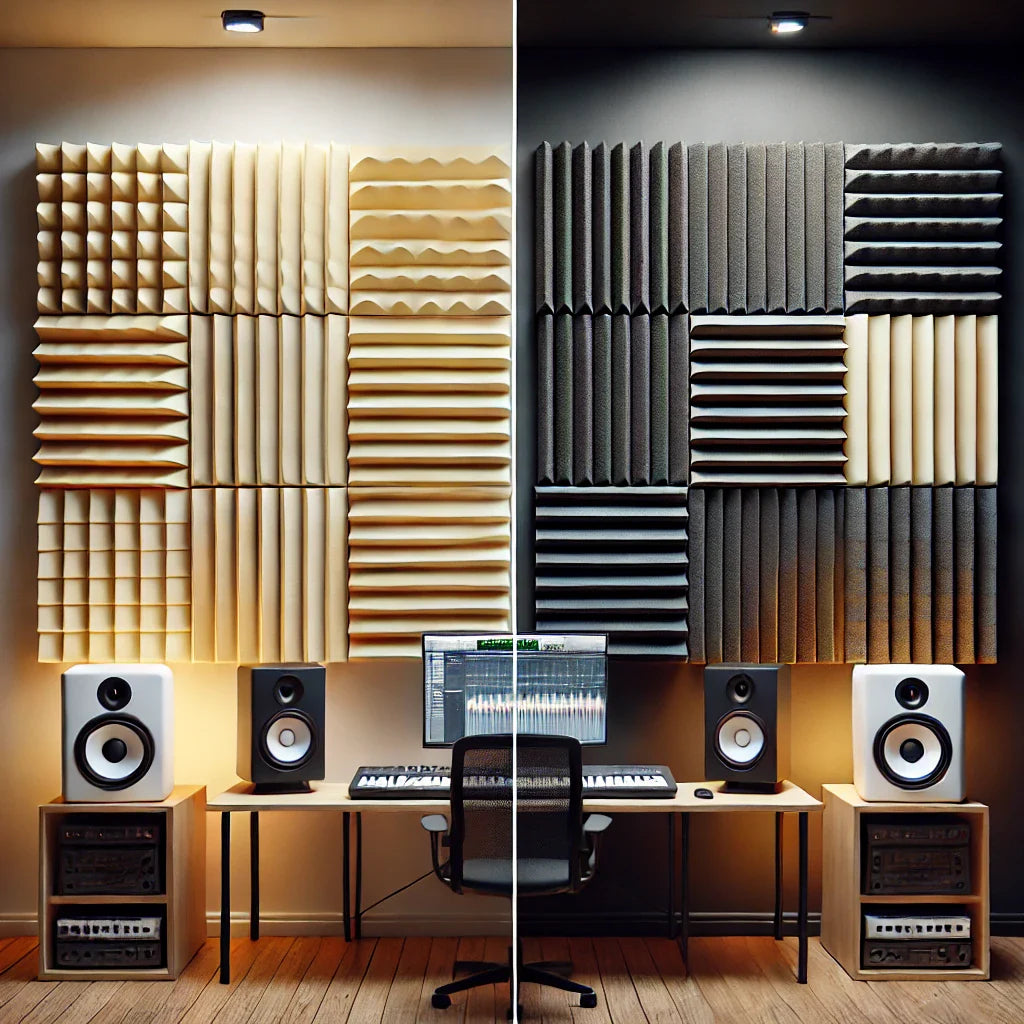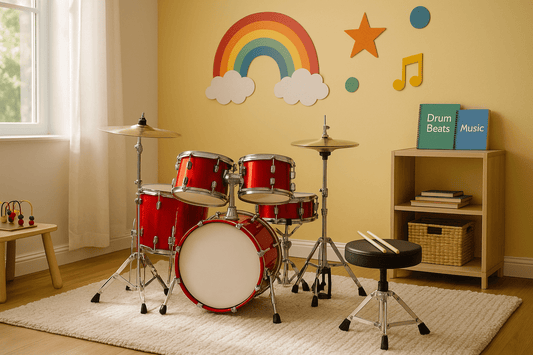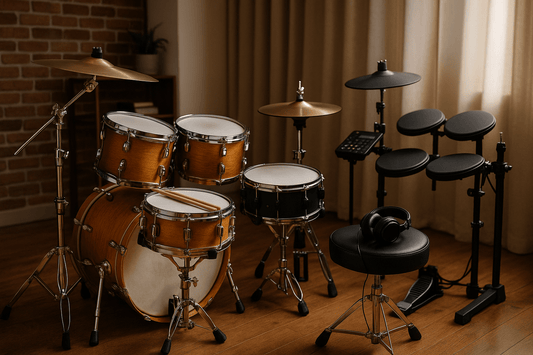Introduction
Why Choosing the Right Foam Style Matters
If you’re building a home studio, podcast setup, gaming room, or any space where sound matters, you’ve likely encountered two popular acoustic foam shapes: pyramid and wedge. While they may seem similar at a glance, their performance, design, and use cases can differ more than you'd expect.
Choosing the right foam type isn’t just about looks—it impacts how well your space manages sound. Whether you're aiming for tight vocal clarity, reduced echo, or improved mixing accuracy, picking the right panel shape can help you get there faster (and with fewer panels).
Quick Snapshot – Wedge vs Pyramid at a Glance
| Feature | Wedge Foam | Pyramid Foam |
|---|---|---|
| Design Style | Angled grooves | Four-sided peaks |
| Absorption Efficiency | Slightly higher surface area (per panel) | Balanced absorption and diffusion |
| Best For | Recording vocals, studios | General echo control, small spaces |
| Aesthetic | Classic, sharp lines | Geometric, 3D style |
| Installation Ease | Slightly more foam per m² | Similar, slightly less dense coverage |
Now let’s break it down in more detail to help you decide which is right for your sound environment.
What is Wedge Acoustic Foam?
Design Characteristics
Wedge foam panels feature a series of angled, evenly spaced grooves—think of them like sound-absorbing “ridges” that give the foam its distinct sharp look.
The wedge design offers:
-
Increased surface area to catch sound waves
-
Efficient sound absorption, especially in mid and high frequencies
-
A professional studio look that’s clean and directional
Sound Absorption Strengths
Wedge foam is designed for maximum sound absorption, with slightly more foam mass per square metre compared to pyramid panels. The linear ridges help catch and trap sound waves before they bounce around the room.
This makes wedge foam great for:
-
Vocal booths
-
Home studios
-
Speaker setups
-
Rooms with noticeable echo or flutter
If you're targeting reverb reduction and tighter sound, wedge foam is the go-to.
Best Use Cases
-
Music recording studios
-
Podcast booths
-
Voiceover setups
-
Home theatres needing mid/high-frequency control
Wedge foam works best where clarity and absorption are priorities, and where you want to minimise room reflections without overcomplicating placement.
What is Pyramid Acoustic Foam?
Design Characteristics
Pyramid foam features raised four-sided peaks across the surface, giving it a grid-like, three-dimensional look. It’s slightly more geometric and symmetrical than wedge foam.
This shape is designed to offer a balance between sound absorption and diffusion, making it ideal for general use across different room types.
Sound Diffusion and Absorption
While wedge foam focuses more on pure absorption, pyramid foam also diffuses sound—breaking up waves and scattering them more evenly across the space.
That means it can help reduce harsh echoes while still maintaining a bit of room “liveliness,” which is ideal for:
-
Small to medium rooms
-
Live performance settings
-
Spaces where a little natural reverb is preferred
Best Use Cases
-
Multi-purpose home studios
-
Small offices or gaming rooms
-
Living rooms and open-plan spaces
-
Streaming setups or acoustic tuning
Pyramid foam is your go-to if you want balanced treatment that looks sleek and modern, without over-dampening your space.
Side-by-Side Comparison – Pyramid vs Wedge
Let’s go deeper into how these two popular acoustic foam styles really stack up in different areas that matter to you as a creator, streamer, gamer, or musician.
Absorption Performance
-
Wedge Foam tends to absorb sound slightly more effectively than pyramid foam due to its larger surface area. The angled grooves catch and trap mid and high-frequency sound waves with precision, making it a favorite for recording environments where clarity is king.
-
Pyramid Foam is not far behind. While it may absorb a fraction less sound due to less foam density per panel, it makes up for it by scattering sound more evenly, preventing echoes from forming hotspots in the room.
Winner: Wedge foam for pure absorption, pyramid for balance.
Diffusion Capabilities
-
Wedge Foam is directional and more focused on absorption than diffusion. It’s great if you want a tight, dead room feel.
-
Pyramid Foam offers more natural sound diffusion, making it ideal if you want to tame reflections without totally killing the room’s character.
Winner: Pyramid foam takes the lead in diffusion.
Aesthetic Appeal
-
Wedge Foam delivers a professional, traditional studio look—clean, sharp, and symmetrical. It’s the industry standard for a reason.
-
Pyramid Foam adds a modern, stylish touch. Its geometric peaks create visual depth, making it a good fit for gaming setups, streaming rooms, or content creation studios.
Winner: Subjective—but pyramid foam is often more visually striking.
Installation and Coverage Efficiency
-
Wedge Foam usually contains more foam per panel, offering a bit more mass per square metre. This can mean better coverage if you're on a budget or trying to hit specific absorption goals.
-
Pyramid Foam installs just as easily, though its slightly smaller peaks may require a bit more panel area to match wedge foam’s absorption output.
Winner: Wedge foam by a small margin for foam density per m².
Cost and Value
The cost between pyramid and wedge foam is often similar. However, because wedge panels may offer more absorption per panel, they might provide slightly better value per acoustic performance—especially in studio use.
That said, pyramid foam may save you on additional diffusion treatment down the track.
Winner: Wedge for absorption-focused setups, pyramid for balanced use cases.
Which is Better for Your Space?
Home Studio Recording
Go with wedge foam. You’ll want tighter control over reflections and reverb for clean vocal or instrument recordings. Pair it with corner bass traps for full-spectrum treatment.
Podcasting or Streaming
Pyramid foam is often the better choice. It improves clarity and speech intelligibility without making your room sound too dead. It also looks great on camera, which is a bonus for streamers.
Gaming Rooms or Offices
Pyramid foam wins again. You get effective echo reduction while maintaining a natural sound. Plus, its design adds a cool, modern vibe to any setup.
Music Production and Mixing
Wedge foam is preferred. You need the most accurate room response possible for critical listening and mixing. Start with wedges, then add pyramid panels or diffusers if needed.
Combining Pyramid and Wedge Panels
When a Hybrid Setup Works Best
In many cases, you don’t have to choose just one. A combination of wedge and pyramid foam panels can give you the best of both worlds—absorption where you need it, and diffusion where you want it.
This is especially useful if you:
-
Have a multi-functional room (e.g., a studio/office or streaming/music combo space)
-
Need to treat different frequency ranges
-
Want to add visual variety or creative acoustic design
For example:
-
Place wedge panels behind your desk, monitors, or vocal mic for focused sound control
-
Use pyramid panels on side or rear walls to reduce echo and spread sound more evenly
-
Install bass traps in corners to manage low-end build-up
The result? A sound-treated room that’s controlled, but still lively and natural.
Acoustic Coverage and Visual Impact
Combining panel types also lets you get creative with your layout. Mix and match textures and shapes for a custom aesthetic—especially useful for streaming, YouTube setups, or branded studios where looks matter as much as sound.
Try alternating patterns:
-
A checkerboard of wedge and pyramid panels
-
Accent walls using pyramid panels for depth
-
Framing wedge panels with pyramid borders for balance
Form meets function—and your ears (and eyes) benefit.
Our Recommended Foam Panels
Wedge Foam – Tempo Gear 50x50x5cm Sound Proof Foam (10 Pack)
If you want reliable, professional-grade acoustic foam that’s easy to install and delivers excellent performance, Tempo Gear’s wedge panel pack is the go-to.
-
High-performance sound absorption for vocals, instruments, and general noise control
-
Large 50x50cm panels give solid wall coverage
-
5cm thickness ideal for home studios, streamers, podcasters
-
Durable, lightweight, and neutral colour to match most spaces
Great for solo use or pairing with pyramid foam for mixed coverage.
Pyramid Foam – Balanced Diffusion in Small Rooms
If you want to reduce echo, maintain some liveliness in the room, and add a decorative vibe, pyramid foam is a fantastic choice. While Tempo Gear specializes in wedge foam, many pyramid-style panels on the market deliver a solid NRC rating and sleek finish.
Browse the Full Collection →
Explore more shapes, styles, and sizes in the Tempo Gear Acoustic Foam Collection to build a setup that’s tuned to your space.
FAQs About Pyramid vs Wedge Foam
Q1: Which type of foam is better for recording vocals?
Wedge foam is typically better for recording vocals due to its slightly higher absorption rate. It reduces reverb and room tone, giving you cleaner raw recordings.
Q2: Can I mix pyramid and wedge panels in the same room?
Absolutely. Mixing both types is actually encouraged for a balanced acoustic environment. Use wedge panels for direct absorption and pyramid foam for diffusion and visual style.
Q3: Does the foam type impact low-frequency sound absorption?
Not significantly. Both wedge and pyramid panels mainly absorb mid and high frequencies. For bass frequencies, you’ll need bass traps—larger, thicker foam installed in corners.
Q4: Is there a major price difference between wedge and pyramid foam?
They’re usually very similar in price, especially when bought in bulk or as part of a starter pack. Wedge foam may offer slightly more coverage per panel, but the choice really comes down to performance needs and visual preference.
Q5: Which one looks better on camera or for streaming?
Pyramid foam often wins on appearance, especially in setups where design matters—like YouTube studios or streaming backgrounds. It offers a more decorative, geometric look.
Conclusion: Choose Smart Based on Your Needs
So, when it comes to acoustic foam pyramid vs wedge, the right answer depends entirely on your space, goals, and sound preferences:
-
Choose wedge foam for maximum absorption and clean audio, especially in studios, vocal booths, and music rooms.
-
Go with pyramid foam if you want balanced sound control with visual appeal, ideal for streaming, casual recording, or home offices.
-
Combine both for a smart hybrid setup that blends function and aesthetics.
No matter which you choose, acoustic foam is one of the best investments you can make for a quieter, clearer, and more creative space.
Start building your sound sanctuary with Tempo Gear’s top-rated foam panels, including the popular 50x50x5cm Wedge Panel 10-Pack, and explore more options in the full Acoustic Foam Collection.




